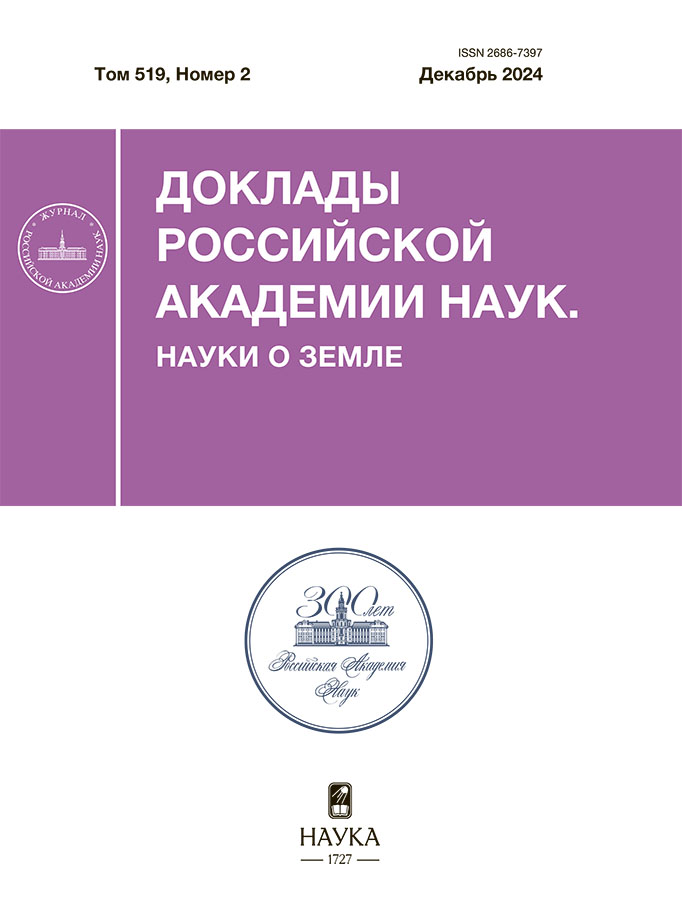Natural environment of the Mammuthus trogontherii in the south of the Russian Far East in the Middle Pleistocene
- Authors: Belyanin P.S.1, Belyanina N.I.1
-
Affiliations:
- Pacific Geographical Institute Far Eastern Branch of the Russian Academy of Sciences
- Issue: Vol 519, No 2 (2024)
- Pages: 91-96
- Section: PALEOGEOGRAPHY
- Submitted: 04.06.2025
- Published: 28.12.2024
- URL: https://edgccjournal.org/2686-7397/article/view/682454
- DOI: https://doi.org/10.31857/S2686739724120125
- ID: 682454
Cite item
Abstract
Palynological data obtained from sediments that include the first find of the tusk fragment – Trogontherii elephant (Mammuthus trogontherii) in the Primorsky krai allowed us to reconstruct its living environment in the Middle Pleistocene. The reconstructed plant formations indicate warmer and drier climatic conditions during the existence of Mammuthus trogontherii in the southern Russian Far East than the modern ones. The ecosystems of the region had a more complex structure. Nemoral plants were more widely represented in them. Mesophilic pine-spruce forests with broadleaf trees and larch-birch sparse forests are presented the main appearance of landscapes. Shrubby birch and alder thickets, sparse larch-birch forests and sphagnum mires occupied plains and lakeshores.
Full Text
About the authors
P. S. Belyanin
Pacific Geographical Institute Far Eastern Branch of the Russian Academy of Sciences
Author for correspondence.
Email: pavelbels@yandex.ru
Russian Federation, Vladivostok
N. I. Belyanina
Pacific Geographical Institute Far Eastern Branch of the Russian Academy of Sciences
Email: pavelbels@yandex.ru
Russian Federation, Vladivostok
References
- Lister A. M., Sher A. V., Essen H. et al. The pattern and process of mammoth evolution in Eurasia // Quaternary International. 2005. V. 126–128. P. 49–64. https://doi.org/10.1016/j.quaint.2004.04.014
- Pawłowska K., Greenfield H., Czubla P. “Steppe” mammoth (Mammuthus trogontherii) remains in their geological and cultural context from Bełchatów (Poland): A consideration of human exploitation in the Middle Pleistocene // Quaternary International. 2014. V. 326–327. P. 448–468.
- Lister A. M., Stuart A. J. The West Runton mammoth (Mammuthus trogontherii) and its evolutionary significance // Quaternary International. 2010. V. 228. № 1–2. P. 180–209. https://doi.org/10.1016/j.quaint.2010.07.032
- Tong H. New materials of Mammuthus trogontherii (Proboscidea, Mammalia) of Late Pleistocene from Yuxian, Hebei // Quaternary Sciences. 2010. V. 30. № 2. P. 307–318.
- Wei G. B., Hu S. M., Yu K. F. et al. New materials of the steppe mammoth, Mammuthus trogontherii, with discussion on the origin and evolutionary patterns of mammoths // Science China Earth Sciences. 2010. V. 53. P. 956–963. https://doi.org/10.1007/s11430-010-4001-4
- Yoshikawa S., Kawamura Y., Hiroyuki T. Land bridge formation and proboscidean immigration into the Japanese Islands during the Quaternary // Journal of Geosciences. 2007. V. 50. P. 1–6.
- Lister A. Mammoth evolution in the late Middle Pleistocene: The Mammuthus trogontherii–primigenius transition in Europe // Quaternary Science Reviews. 2022. V. 294. Paper 107693. https://doi.org/10.1016/j.quascirev.2022.107693
- Косинцев П. А., Бобковская Н. Е., Бородин А. В. и др. Трогонтериевый слон Нижнего Иртыша. Екатеринбург: Волот, 2004. 260 с.
- Мащенко Е. Н., Андреев А. А., Воскресенская Е. В. и др. Палеоэкологические условия формирования местонахождения Mammuthus trogontherii в Оханском районе Пермского края // Пути эволюционной географии. Выпуск 2. М.: Институт географии РАН, 2021. С. 233–237.
- Баранов А. Ф. Находка остатков мамонта близ станции Вяземской // Вопросы географии Дальнего Востока. Сборник 1. Хабаровск: Дальневосточное государственное издательство, 1949. С. 144–145.
- Громов В. И. Палеонтологическое и археологическое обоснование стратиграфии континентальных отложений четвертичного периода на территории СССР (млекопитающие, палеолит) // Труды Института геологических наук АН СССР. 1948. Вып. 64. Геологическая серия. № 17. М. – Л.: АН СССР, 1948. 520 с.
- Ганешин Г. С., Смирнов А. М. К стратиграфии четвертичных отложений приморского края и прилегающих территорий // Геология и геофизика. 1960. № 5. С. 28–39.
- Никольская В. В. О нахождении костей трогонтериевого слона в четвертичных отложениях юга Советского Дальнего Востока // Проблемы физической географии. М.: АН СССР. 1951. Выпуск 17. С. 224–228.
- Казачихина Л. Л. Палинологические комплексы из отложений, содержащих кости вымерших млекопитающих // Проблемы изучения четвертичного периода. Хабаровск, 1968. С. 41–45.
- Климова Р. С., Феоктистов Ю. М. Определение возраста комплексов микрофауны палеозоя-среднего мезозоя, флоры верхнего мела-палеогена Центрального и Западного Приморья. Книга V // Литология и флора кайнозойских отложений Нижнебикинской и Павловской впадин. 1989. 87 с.
- Голозубов В. В., Донг У. Л., Касаткин С. А. и др. Тектоника кайнозойской Нижнебикинской угленосной впадины (Северное Приморье) // Тихоокеанская геология. 2009. Т. 28. № 3. С. 74–89.
- Ohwi J. Flora of Japan. Switsonian Institute, Washington, 1965. 1067 pp.
- Белянина Н. И., Белянин П. С. Палеорастительность аккумулятивной равнины р. Туманная (Туманган) в среднем неоплейстоцене // Тихоокеанская геология. 2014. Т. 33. № 4. С. 110–116.
- Lee T. B. Illustrated flora of Korea. Seoul: Hyangmunsa, 1980. 1000 p.
- Короткий А. М., Караулова Л. П., Троицкая Т. С. Четвертичные отложения Приморья: стратиграфия и палеогеография. Новосибирск: Наука, 1980. 234 с.
Supplementary files












